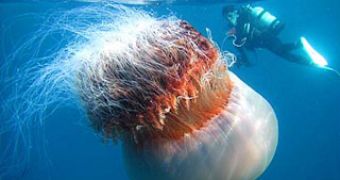Jellyfish do not have the "common sense" to always show themselves in the size of a (little) plate. Sometimes they can be enormous monsters, 2m (6 ft) in diameter and 200 kg (450 pounds) heavy. This is the case of the Nemopilema nomurai. Such monsters can easily break fishing nets and kill the fish captured inside them. But when there is an invasion of millions of such beasts, things turn really nasty.
This is the problem faced by fishing communities at the Sea of Japan in recent years. Now, scientists have found a use for the huge gelatinous carcasses: their protein could be employed for food, cosmetics, and drugs.
In the same area, a great nuisance are also the smaller moon jellyfish (Aurelia aurita): they'v become so numerous that they have blocked the cooling system intake at a power plant and have transformed beaches into graveyards of rotting gelatinous corpses.
Many blame the bloom of jellyfishes on the agricultural runoff, that flawed nutrients in the water that enhanced the development of the juvenile jellyfishes. Another cause could be overfishing of the jellyfishes' predators.
Their huge number made fishermen give up chopping them. But researches have come up with the idea of using them as baking powder for cookies and crunchy snacks made of dried and salted jellyfish pieces.
Investigations also discovered inside the jellyfishes a lot of mucin types, a type of sugar-proteins being the main component of saliva and mucus.
The team led by biochemist Kiminori Ushida at the Institute of Physical and Chemical Research (RIKEN) in Saitama, Japan, called the jellyfish mucin "qniumucin" ("kuniumu" means "rebirth of a country", from the effort of transforming the pest into a national resource).
"Its tendency to form a gel might make it useful as an emulsifier in food or a moisturizer in cosmetics, and it could be used as a substitute for gastric juices in people with certain digestive diseases. Qniumucin could also replace cow-derived gastric mucins used in medicines that were taken off the market because of worries about bovine spongiform encephalopathy, mad cow disease." said Ushida.
60 grams of qniumucin can be extracted at the moment from each giant jellyfish; but across five investigated jellyfish species, the chemical structure is the same.
"Tests will have to show that qniumucin doesn't provoke an immune reaction before it can be used medically. But the study could offer new insights into the evolution of proteins. We don't know how we arrived at the mucin structures we have in higher mammals," said mucin biologist Tony Corfield of the University of Bristol, U.K., Corfield.

 14 DAY TRIAL //
14 DAY TRIAL // 
